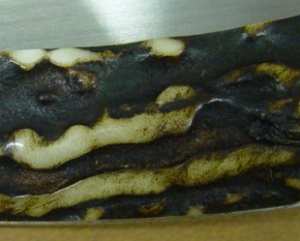STAG HANDLED KNIVES
And what to look for
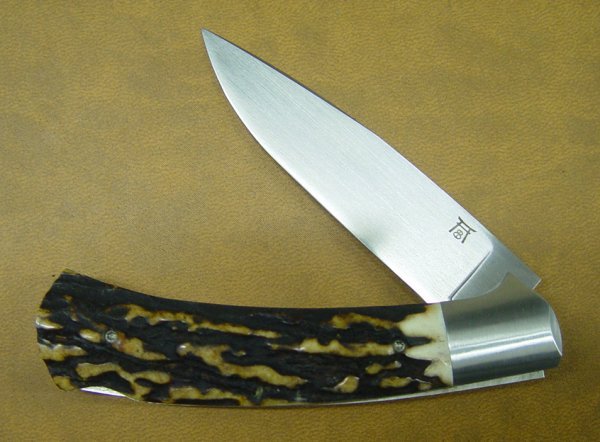
Stag antler has long been one of the traditional knife handle materials. Its chunky, its beautiful, its functional, its strong, and its natural.
There's stag, and there's stag, and there's "second cut" stag. Let's look at a few examples. The one above, by the way, is one of the most gorgeous examples of Sambar Stag that I have ever seen. I just fell in love with this folding Bowie knife by Bailey Bradshaw when I first saw its photograph.

Above: Two examples of natural stag
Below: Burnt Sambar Stag

Sambar. WOW!
Its on a Queen Mountain Man Lockback (2005)
Sambar Stag
Sambar Stag is the most beautiful. The animal is most commonly found in India and surrounding countries, and also in Malaysia. In 1998 India, which was the most common source, banned the export of Sambar Stag antlers. Knife makers now have to source the material from other countries, where it is more expensive, and indeed many knife making companies have now ceased using Sambar Stag altogether, and have opted for the less expensive European Stag (see below).
Sambar Stag has a natural surface which is deeply figured, and particularly "gnarly" on appearance. It is fairly usual these days to see "burnt stag" on knife handles. The surface is burnt with a torch, to give it some amber colour, although naturally, the inner material is white.

The surface of Sambar Stag polishes beautifully, and that gives a big contrast between the natural dark surface and the inner material.
One of the things to look out for when buying a stag handled knife is the thickness of the handles. You will like either thick chunky handles, or you will like thin ones. But there is much more difference than just that. Look at the two knives below. The top one has thin handle material, and the lower one has thick handles. Note how, on the thick one, the surface of the material has had to be thinned away to bring it down to the bolsters, revealing more of the inner material of the antler. The thinner handled knife has not needed to be thinned so much, and therefore the natural surface extends right to the bolsters. The choice as to which is best is personal.
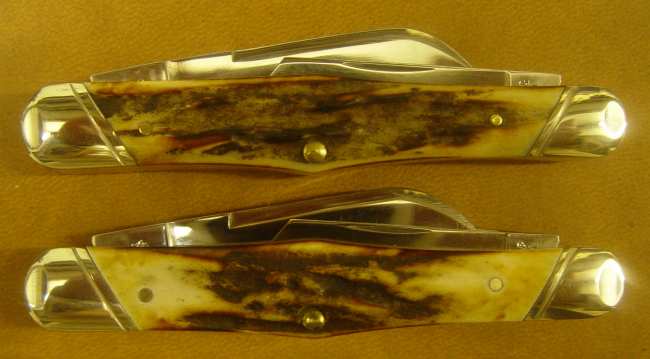
Schatt & Morgan Series 15 Whittlers (2005). Amazing Sambar. And Queen
Cutlery Co. sourced enough of this stuff to make a production run of 600
of this knife.
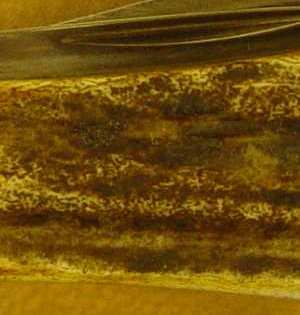

Above, an example of European Stag with some of the natural surface showing,
but it isn't deep like the Sambar.
European Stag
A good European Stag can be beautiful, but it just can't compare with Sambar Stag. You'll see in the example in the photograph here on the left how it has a pitted, "dusty" and dry looking surface. A totally different appearance when compared with the Sambar. (And this is an example of a good piece).

|
This knife is representative of an average European Stag. It is very unusual to find a knife with surface material right up to the bolsters. If you do, then you have a good one. |
This is the material in its natural state.


This is an example of a really good second cut stag (it has been dyed red).
But those indentations are not natural. They have been jigged to give a real
stag appearance. What makes this one more realistic, is that you can't easily
see the milling marks, and the high spots are polished up just like Sambar.
(This one is a Queen Classic Whittler of 2005)

Does this one by Bulldog really convince you? It is sold as "Winterbottam
Stag". To be honest, I can't tell you whether it is a second cut real stag
or bone.
Second Cut Stag
Second cut stag is where the inner part of the antler material is used. It is the plain material left over after the natural surface parts have been sawn off. Hence "second" cut (a seconds quality). Very often such knives will then have a milled jigged surface that tries to simulate the natural stag surface. Sometimes it is done well, and sometimes it fails to be convincing.
Do you see the milling marks in this one below? The material is real stag, but the surface isn't, and it isn't at all convincing either.
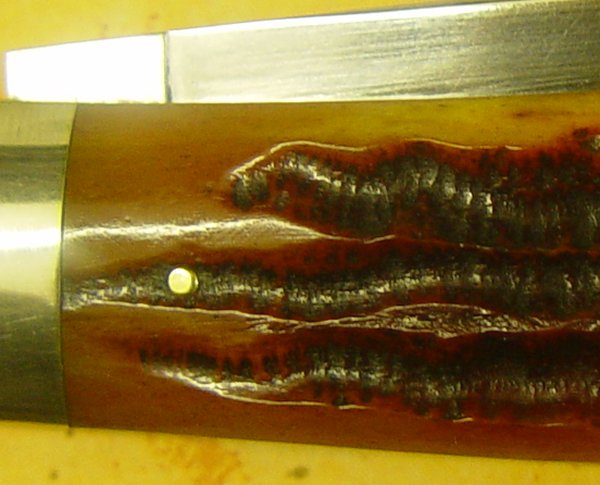
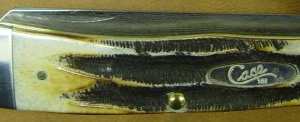
Above: a Case "Bone Stag".
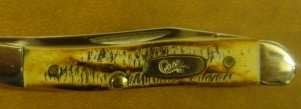
Above: a more convincing "Bone Stag".
"Bone Stag" or "Stag Bone"
Due to the shortages and expense of real stag, many manufacturers have started to use bone, and jig it to "look like" stag. Its beef bone. Again, it shows those milling marks.
Take your pick. Both knives below are Bear Mfg. Co. knives, an older one with Sambar Stag, and a newer one with "Stag Bone".

Comparisons
Below are three stag handled knives. The top one is a typical example of a European Stag handled knife, the middle one is a very poor example of European Stag, and the bottom one is Sambar Stag.

Some Examples of Stag Handled Knives

An older Case Sambar Stag Trapper. Gorgeous.

An exceptional European Stag on this Case Seahorse Whittler. So good, in
fact, that I have a suspicion that someone at Case found a piece of
Sambar and put it on!
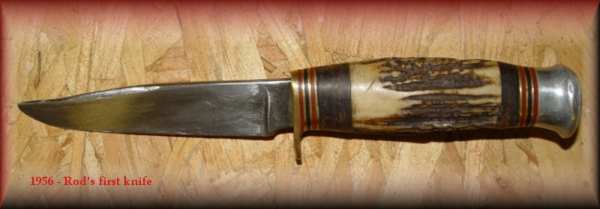
My very first stag handled knife. In its day (1956) all the kids wanted real
stag, and I was the envy of my friends.

A large Bulldog Wharncliffe Whittler. It must be a European Stag, but its
an exceptionally good one. Most of the Bulldog stag handled knives are like
this.

A Sambar Stag Case pen knife

A pair of 1999 Case Stag Whittlers. The top one is Sambar Stag, and the bottom
one is European Stag.

An exceptional custom-made stag handled knife by Ray Cover Sr. (Engraving
by Jere Davidson).

A Bailey Bradshaw Folding Bowie with absolutely stunning Sambar Stag.
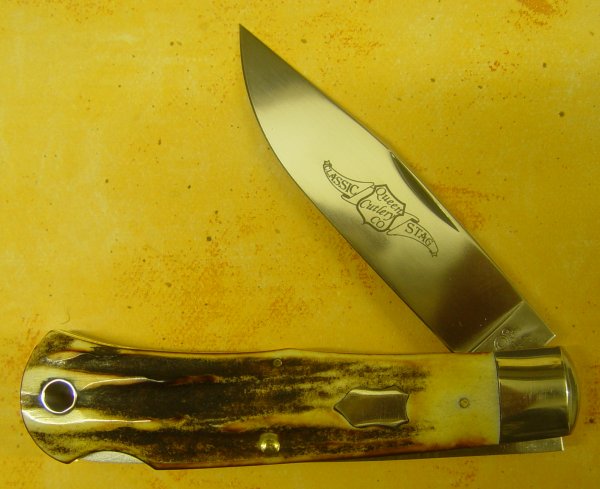
A Queen Classic Stag Mountain Man. (Sambar Stag)
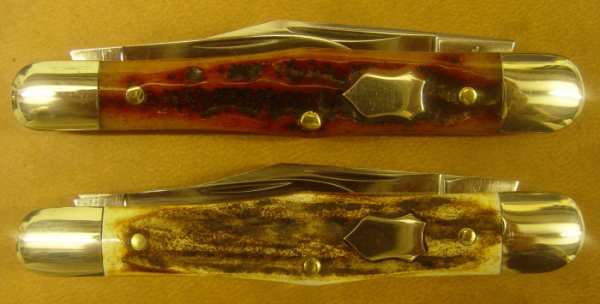
A pair of Queen Classic Whittlers (2005) One with second cut Red Stag (nice!)
and the lower one with European Stag. It isn't like Sambar, but this is Euro-Stag
just about as good as it gets.
Copyright ©2005 Rod
Neep All Rights Reserved
Photographs by Rod Neep
